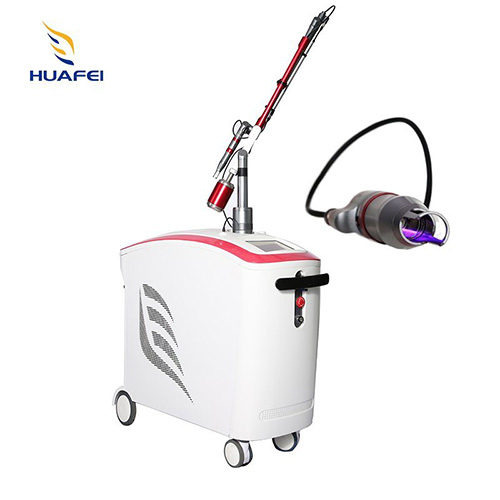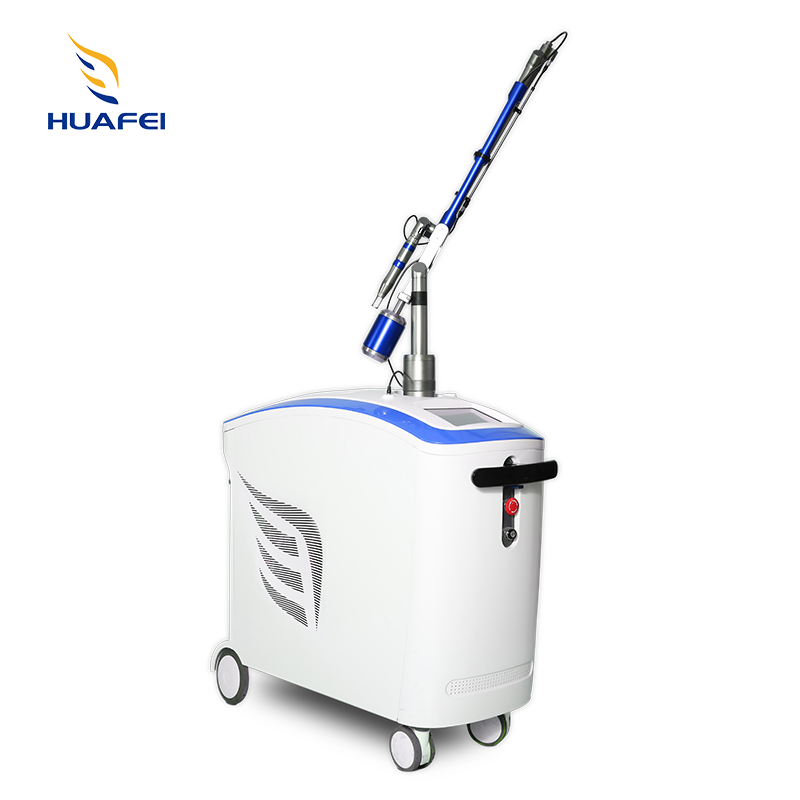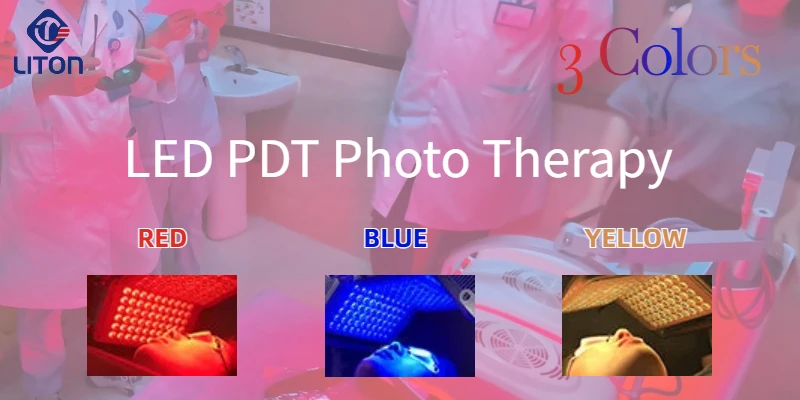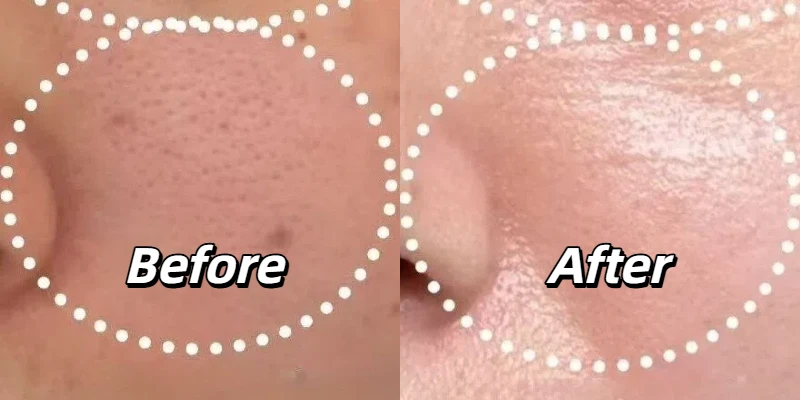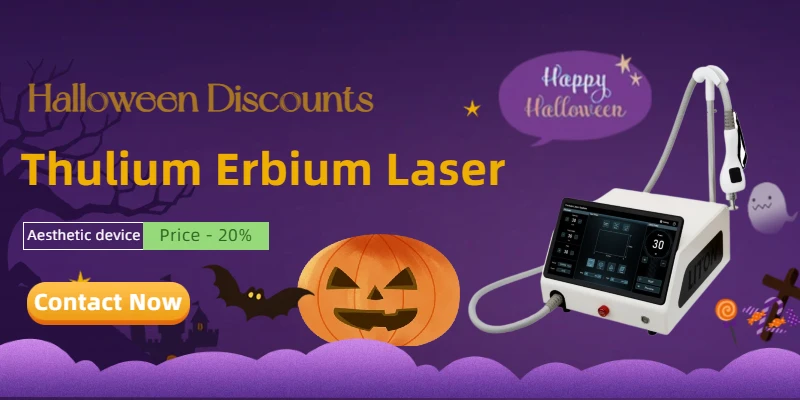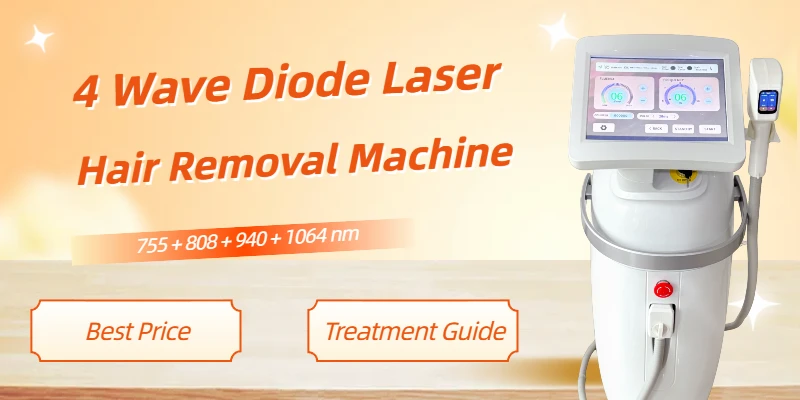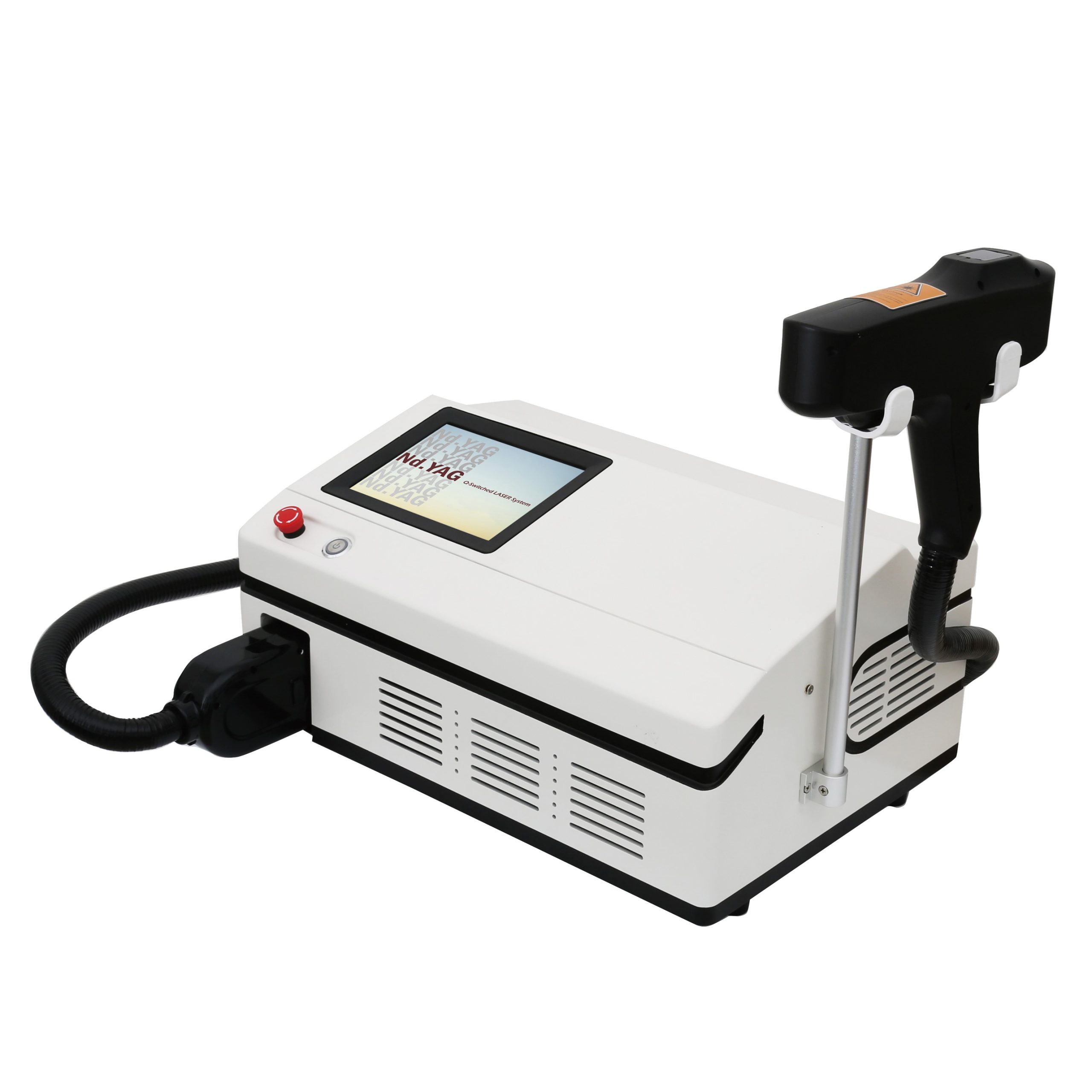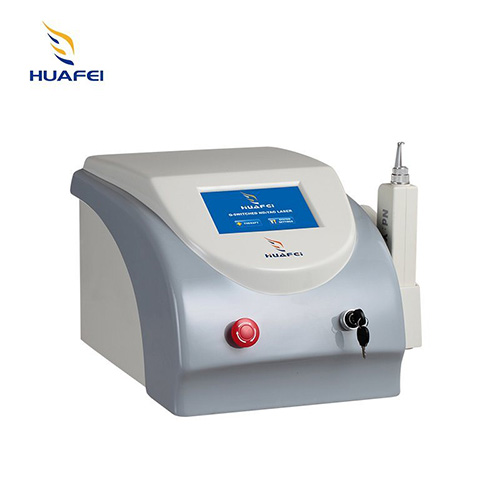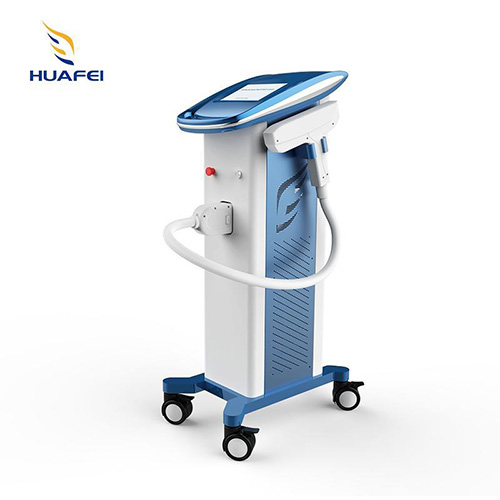Tattoos, as a unique artistic expression, have been used by many people to freeze the memory of youth, commemorate the highlights of life, and show self and personality. However, as time goes by, many people start to think about how to “remove tattoos with one click” due to aesthetic changes, work needs, or simply wanting to change their style. However, tattoo pigments “take root” in the dermis, just like “nail households”, it is not easy to drive them away, and many people have tried their best but still have little effect.
If you want to remove all tattoos safely, laser tattoo removal is currently the most effective tattoo removal method. The laser treatment equipment used is highly targeted and can effectively remove tattoos through its selective photothermal principle.
Simply put, this type of laser only targets pigments, not normal skin tissue, so it can help perfectly remove tattoos. Many people are worried about whether the treatment will hurt? How to take care of it after treatment? And will it leave scars? What are the results before and after treatment? Then tell you clearly at once today!
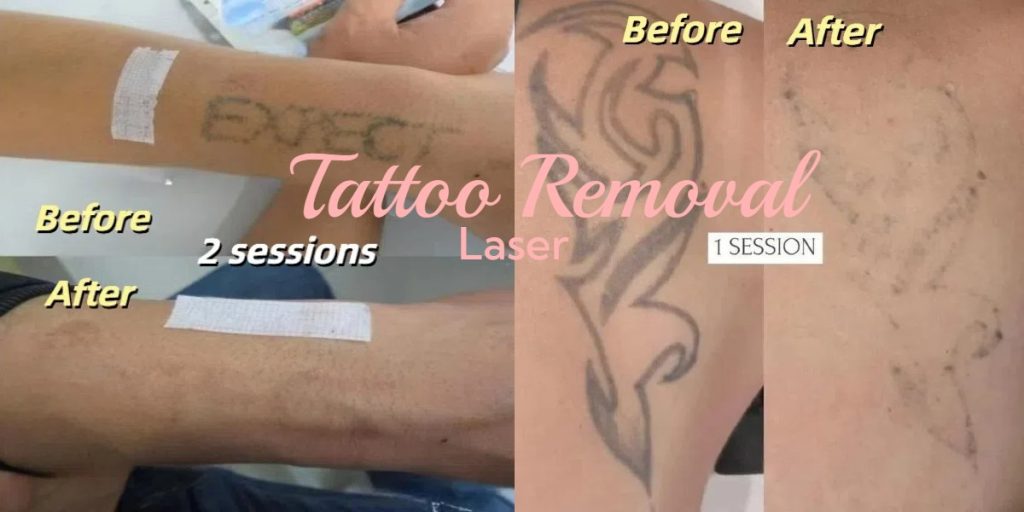
How does laser tattoo removal work?
The principle of laser tattoo removal is based on the “selective photothermal effect” and “photoblasting principle”. The laser penetrates the surface of the skin and is absorbed by the tattoo pigment particles, instantly producing a blasting effect, breaking the pigment particles into smaller particles. These particles are then cleared by the body’s immune system and excreted through metabolism.

Tattoos of different colors require targeted treatment with lasers of different wavelengths. For example, lasers with wavelengths of 755nm and 1064nm are suitable for removing black and dark blue pigments, while 532nm wavelengths are effective for red, orange and yellow inks. This “precision strike” can not only effectively decompose tattoo pigments, but also protect the surrounding normal skin to the maximum extent.
What are the benefits of laser tattoo removal?
Compared with traditional tattoo removal methods (such as surgical excision, chemical peeling, etc.), laser tattoo removal has the following advantages:
- Non-invasive: Laser treatment is a non-invasive method that does not cause extensive damage to the skin.
- Accurate and efficient: The laser can accurately act on the tattoo pigment to minimize damage to the surrounding normal skin.
- Fast recovery: The skin recovers quickly after treatment and does not leave obvious scars.
What is the laser tattoo removal treatment process?
Before laser tattoo removal, the doctor will conduct a comprehensive assessment of the size, color, location and depth of the tattoo to develop a targeted treatment plan. During the treatment, the doctor will use laser to treat the pigment in the tattoo area.
A single treatment usually takes a few minutes to dozens of minutes, depending on factors such as the size and color of the tattoo. There may be a slight stinging sensation during the treatment, but this discomfort is tolerable and can be alleviated by local anesthesia or cooling equipment.
Each treatment needs to be separated by a certain period of time (usually 3-6 months) to allow the skin to have enough time to recover, so the recovery period for laser tattoo removal is 3 to 6 months.
What should you pay attention to before and after laser tattoo removal?
Before laser treatment:
- Assess skin condition: Before treatment, make sure your skin is healthy and free of infection, inflammation, and other problems.
- Avoid sun exposure: Avoid excessive exposure of the tattooed area to the sun in the weeks before treatment to avoid affecting the treatment effect.
After laser treatment:
- Skin care: After treatment, the skin may experience redness, swelling, itching and other reactions, which is normal. Avoid scratching and keep the skin clean.
- Sun protection: The skin after treatment is more sensitive, so avoid direct sunlight and apply sunscreen when going out.
- Be patient: Complete tattoo removal requires multiple treatments and a certain amount of time, so you need to be patient.
Results of laser tattoo removal
The results of laser tattoo removal vary from person to person, depending on the color, size, depth of the tattoo, and the individual’s skin condition.
Generally speaking, darker tattoos (such as black and dark blue) are more easily removed by laser because the pigments in these colors absorb the laser more strongly. For complex, multi-colored tattoos, multiple treatments may be required to achieve the desired effect.
The color of the tattoo will fade further after each laser treatment, and eventually, after multiple treatments, the tattoo will be removed. Most people can see a significant reduction in the size of their tattoos or even complete disappearance after several laser treatments.
In addition, laser tattoo removal rarely leaves noticeable scars on the skin, and recovery after surgery is good.
Pico laser tattoo removal before and after pictures
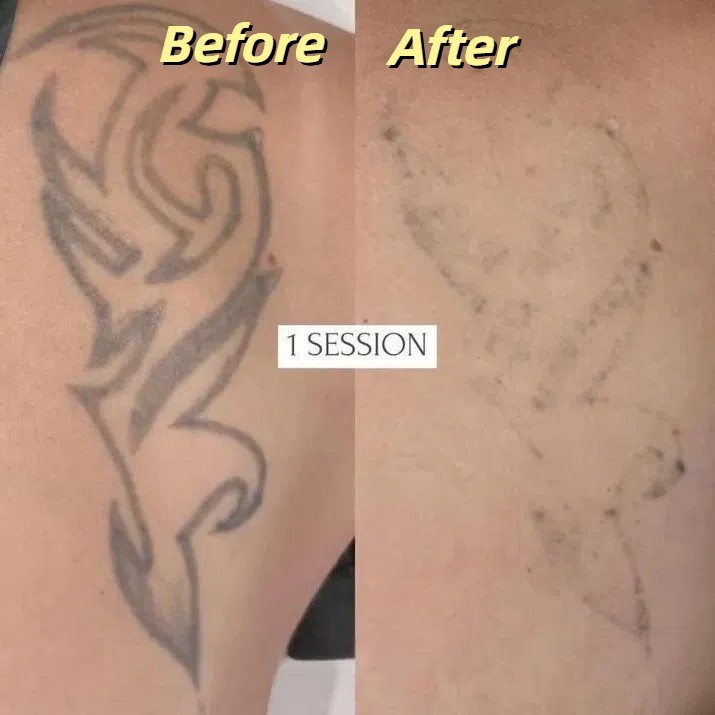
After just one treatment with pico laser, you can see very noticeable results in tattoo removal.
If you still understand, you can also think like this:
Tattoo pigments are exogenous pigments. The color of the pigment is left after the skin is scratched, forming a fixed pattern on the skin. If you want to maintain it for a long time, that is, the color is left for a long time, then the depth of penetration must enter the dermis, so from the outermost layer to the deepest layer, the color will be left. With the body’s own metabolism, some of the shallow pigments will gradually fade, and the small particles of the deep pigment will be metabolized, while the large particles will be wrapped by the collagen fibers produced by the skin and stabilized in the skin layer.
Laser irradiation of the skin is irradiated from the outside to the inside. The shallow pigment is absorbed first, and then the deep pigment. Therefore, tattoo removal requires multiple cleanings, and as the number of times increases, the color of the pigment fades, and it becomes more and more difficult to clean later, which is what we often call the final treatment effect.
But the final therapeutic effect has a lot to do with the energy level of the laser machine, a small part of it has to do with the beautician’s operating skills, and part of it has to do with the body’s self-healing ability.
Q-switch laser tattoo removal before and after pictures
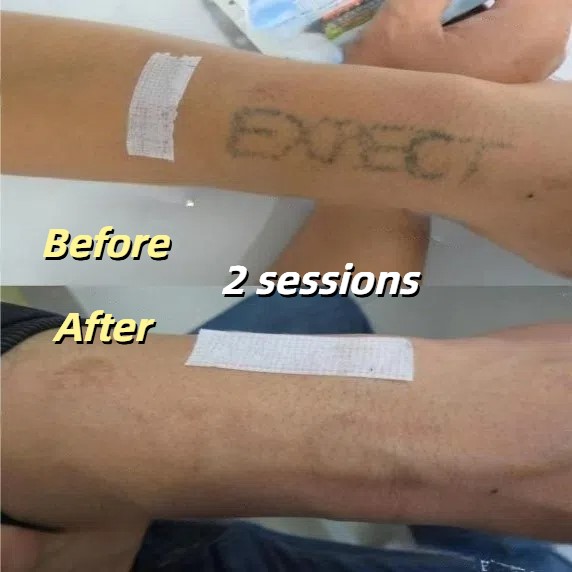
The results of tattoo removal using 2 treatments with Q-switched laser are also excellent.
What are the side effects of laser tattoo removal?
Immediate complications following laser tattoo removal include blistering, crusting, pain, and punctate bleeding. Patients should be educated about these potential immediate effects and offered anticipatory treatment. Pain and swelling following tattoo removal can be relieved by the use of ice.
If crusting occurs, patients should be advised not to pick at the treated area to avoid infection and pigmentation issues. Laser tattoo removal may also cause hypopigmentation, or under- or over-pigmentation, which is a concern in patients with darker skin tones.
In addition, if the tattoo contains red or yellow pigment, local allergic reactions may occur, manifesting as papules, nodules, or pruritic plaques. Other complications include paradoxical darkening of the tattoo, as iron oxide or titanium dioxide can be reduced by laser energy, producing a darker pigment.
How to remove tattoos of different colors?
The 1064nm laser is used to remove blue or black tattoos, while the 532nm laser is used to remove tattoos with red pigment.
Studies have shown that 532nm Nd:YAG is superior to QS Ruby and QS 1064nm ND:YAG in removing red pigment tattoos.
More tattoo colors and results of different wavelength treatments are shown in the figure below:
Results of using multiple wavelengths to remove different colored tattoos
| Tattoo Color
Wavelength |
Black | Blue | Purple | Green | Red | Orange | Yellow | Brown |
| 1064nm laser
(Nd:YAG) |
Well | Good | Good | Good | Bad | — | Bad | Good |
| 532nm KTP laser
(Frequency-doubled Nd:YAG) |
Bad | Bad | Bad | Bad | Well | Good | Good | Bad |
| 755nm alexandrite or diode laser | Well | Good | Good | Good | Bad | — | — | Bad |
| 694nm ruby laser | Well | Good | Well | Good | Bad | — | Bad | Good |
| 510nm dye laser | Bad | Bad | Bad | Bad | Well | — | Bad | Bad |
| 585nm dye laser | — | Good | — | Well | — | — | Well | — |
What are the laser tattoo removal machines?
The laser machines currently used to remove tattoos are Q-switch lasers and pico lasers, with wavelengths mainly at 1064nm and 532nm, as well as some at 694nm, 755nm and other wavelengths.
Pico Laser Tattoo Removal Machine
Pico laser uses very short pulse output mode, instead of thermal effect, by the principle of the light mechanical shock wave, pigment is shattered into finely granular via focused energy, are more likely to be absorbed by the body metabolism.
Q-Switch Laser Tattoo Removal Machine
Q-switch laser skin treatment mainly relies on mechanical effects. Through the principle of photomechanical shock waves, tattoo pigments are crushed into fine particles by focusing energy, making them easier to be metabolized by the human body.
The 6ns pulse width output can reduce the impact of thermal effects and is also convenient for observing skin reactions during treatment. It has a good effect on treating pores.
Laser tattoo removal Q&A
How many treatment handpieces does a laser tattoo removal machine have? What are their functions?
The laser tattoo removal machine produced by Liton Laser is equipped with two handles as standard, a white light handle (short head) 1064nm and a green light handle (long head) 532nm. The 1064nm handle removes blue, black, and cyan tattoos, while the 532nm handle mainly removes red, coffee, and brown tattoos. If the customer needs it, a 755nm honeycomb handle can also be added.
How to set the treatment parameters of the tattoo removal machine? What is the distance between the machine and the skin?
The treatment parameters when using laser tattoo removal should be controlled according to the sensitivity of the individual’s skin. For sensitive skin, the handle should be closer to the skin and the energy should be adjusted lower. It is recommended that the treatment energy of 1064nm be adjusted from 100mj, and the treatment energy of 532nm is half of 1064nm. The frequency should start from 1hz for beginners, and can be adjusted to 4-6hz after gradually becoming proficient. The treatment handle should be placed against the skin for energy testing and observation. If the tattoo color does not respond, the energy needs to be increased. When the energy cannot be adjusted up any further, the handle should be slightly raised to make the light spot on the skin smaller. When the energy remains unchanged, the energy density increases, and the ability to break the pigment is enhanced. However, the handle cannot be raised blindly. When the handle is raised to a certain degree, the diameter of the light spot gradually decreases, and the ability to damage the epidermis is enhanced. Finally, the energy of the light is concentrated in the superficial position, causing skin damage. In mild cases, blisters and bleeding occur, and in severe cases, postoperative infection and scars are left!
What is the treatment endpoint of laser tattoo removal? How long is the downtime?
Keep the machine close to the skin as much as possible and use appropriate energy for treatment. The endpoint reaction of 1064nm is: the pigment of the treated area becomes lighter immediately, and there will be delayed reaction bleeding. The endpoint reaction of 532nm is: the treated area turns white immediately, and the delayed reaction turns black or brown. However, it should be noted that some tattoo pigments contain metal iron ions. After laser irradiation, the color will change from black gray to red brown.
For common blue and black removal, choose 1064nm handle treatment. For red and coffee color, choose 532nm handle treatment. The downtime of laser tattoo removal is 30-45 days. According to the recovery of the skin, the next treatment will be carried out. The cycle treatment is until the pigment does not absorb light.
Is laser tattoo removal painful?
During the tattoo removal process, there will be a burning and stinging sensation. Tattoo removal is painful because the laser penetrates the skin. Although it cannot be seen with the naked eye, the laser has actually acted on the pigment in the skin. Generally, applying epidermal anesthetic cream for 45-60 minutes before the operation can effectively reduce the pain. At the same time, using cold air during the treatment will make the patient feel more comfortable. Immediately after the operation, ice cubes should be used for ice compresses for at least 2 hours (not keeping it still all the time, but intermittent ice compresses to cool down) until the skin no longer feels hot. After the operation, use a moist burn cream to remove dead tissue and promote wound healing.
How many times does it take to remove a tattoo with laser?
If you want to completely remove a tattoo, it is basically impossible to do it with just one treatment. The color will become lighter after one or two or even three treatments. If the tattoo is too deep, the color will be very light in the end, and it can be barely seen from a distance of 1.5 meters. Then the treatment can be ended. Some people who want to be more perfect need to completely remove the tattoo. At this time, they need to choose pico laser combined with CO2 fractional laser for another treatment, which will be very difficult.
What should I do if redness and swelling occur after laser tattoo removal?
After laser treatment, the skin will have tissue edema and redness. At this time, it is necessary to apply ice compresses to cool down in time, and use anti-inflammatory and anti-redness and swelling topical medications to help calm the skin, reduce inflammation and relieve pain.
What to do if blisters appear after laser tattoo removal?
After laser tattoo removal, the temperature of the skin tissue rises and needs to be cooled. However, if the cooling treatment is not timely or continuous, blisters will appear. You need to use a disposable syringe to poke a small hole at the bottom of the blister, roll it with a medical cotton swab to drain the tissue fluid, apply moist burn ointment, and do not touch water. If the skin still feels hot, you can use ice or cold compresses to cool it down.
Does laser tattoo removal leave scars?
Laser tattoo removal generally does not cause scars. However, in areas where joints move and the skin is severely damaged, if there is no timely anti-inflammatory, sedative and repair after the operation, and if there is no postoperative care, inflammation and infection may occur, which can easily lead to scar formation. If the skin is edematous and red and swollen after the operation, you can choose to use Bactroban for anti-infection and anti-inflammatory; you can use MEBO moist burn ointment to remove dead tissue and regenerate new tissue; you can use epidermal growth factor gel to promote epidermal healing; if there are signs of scar hyperplasia, use Buck gel or Mepiformin to prevent scar formation; if scars have already formed, you can use Centella asiatica ointment and triamcinolone acetate urea ointment.
How much do laser tattoo removal machines cost?
If you need an efficient and high-quality tattoo removal laser machine, then Liton Laser is your best choice.
We have pico laser and Q-switch laser options, and there are multiple options for laser wavelength, laser energy, laser shell, etc. We will provide the most suitable machine according to your treatment needs and give the best machine price.
If you are interested, please feel free to contact us.

